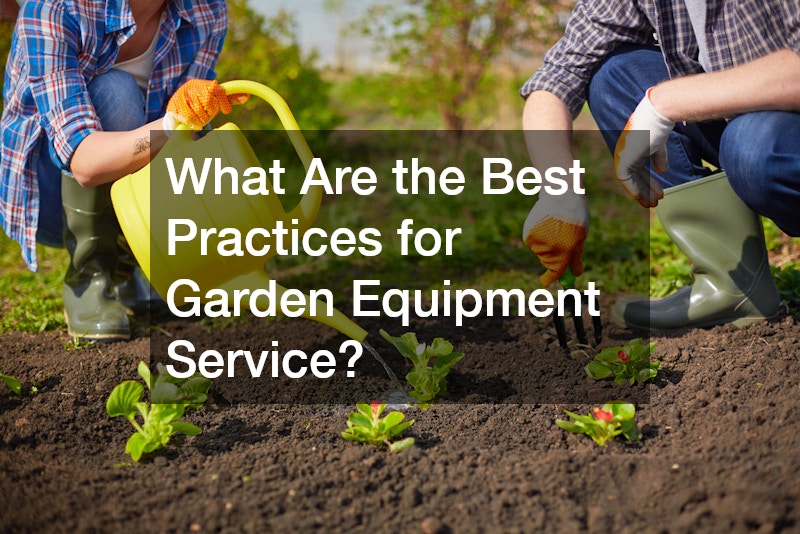Regular maintenance of your garden tools and machinery not only extends their lifespan but also ensures peak performance when you need it most. Whether you’re a home gardener or managing larger grounds, staying on top of service routines helps avoid unnecessary breakdowns, costly repairs and delays in outdoor work. Proper garden equipment service is about more than fixing problems when they arise, it’s a proactive approach to keeping your tools reliable and ready for use year-round.
Clean After Every Use
One of the simplest yet most effective maintenance practices is cleaning equipment immediately after each use. Garden tools and machinery are often exposed to dirt, grass, sap and moisture; all of which can lead to rust, corrosion or clogged mechanisms if left unattended.
Hand tools such as spades, secateurs and trowels should be rinsed and dried thoroughly, while powered equipment like lawn mowers or chainsaws needs extra attention to remove debris from blades, vents and moving parts.
Using a brush to clean off soil and grime is a good start. For sticky residue, a cloth and a mild detergent solution can help. After cleaning, dry all surfaces completely before storing the item. This simple habit can prevent premature wear and maintain tool functionality over time.
Sharpen Blades and Replace Worn Parts
Blades, edges and cutting components are subject to the most wear. Dull mower blades tear grass rather than cut it cleanly, leading to lawn damage. Pruning shears and hedge trimmers also become less effective and more dangerous when their edges degrade. Sharpening your blades regularly, ideally every few months during peak gardening seasons, will ensure a clean cut and reduce stress on the equipment motor or the user.
It’s also important to inspect moving parts such as belts, spark plugs, air filters and fuel lines. Replace worn-out or cracked components promptly. This helps maintain the efficiency of the tool and minimises the chance of sudden breakdowns during use. As part of a regular garden equipment service, these components should be assessed and maintained to ensure your tools continue to operate safely and effectively.
Keep Fuel and Fluids Fresh
For petrol-powered tools, stale fuel is one of the most common causes of startup problems and poor performance. Petrol can degrade within a few weeks, especially if left exposed to air or stored in high temperatures. Use fresh fuel and store it in sealed, approved containers in a cool, shaded area. If equipment is not used frequently, consider using a fuel stabiliser to extend its shelf life.
Oil levels also need regular checks. Just like a car engine, garden machinery relies on clean oil for lubrication and cooling. Replace oil at recommended intervals or whenever it becomes discoloured or gritty. For battery-powered gear, check charging ports and keep battery contacts clean. Remove batteries from tools if they will be stored for extended periods.
Store Equipment Properly
Correct storage can make a significant difference in how well your tools hold up over time. Store tools in a dry, well-ventilated shed or garage to protect them from moisture and extreme weather. Use hooks or shelving to keep items off the ground, especially heavy equipment like lawn mowers or trimmers.
Hand tools should be kept together, ideally hanging, to avoid bent edges or broken handles. Power tools should be covered or placed in cases to avoid dust accumulation. It’s also wise to drain petrol from tanks if a machine will be unused for an extended time, such as over winter. This avoids clogging the fuel system and prevents rubber seals from degrading.
Schedule Seasonal Checks
A scheduled garden equipment service is essential at least once or twice a year, particularly before spring and after autumn. These seasonal checks provide an opportunity for thorough inspections that go beyond your day-to-day maintenance. Professionals can spot signs of engine wear, calibrate settings, and clean or adjust components that may be difficult to manage without training.
Seasonal servicing often includes oil changes, blade sharpening, filter replacement and safety inspections. While some gardeners may prefer to do this themselves, others benefit from having their tools professionally serviced to ensure everything operates safely and efficiently.
Well-maintained garden equipment is the key to productive and enjoyable gardening. By adopting best practices such as cleaning after each use, sharpening blades, monitoring fuel and oil, and storing tools properly, you ensure that your gear is always ready for the task at hand. Regular seasonal checks or professional garden equipment service provide added assurance that your tools are running at peak performance.
.


